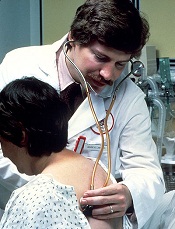
Credit: NCI
The risk of premature menopause among survivors of Hodgkin lymphoma (HL) may vary greatly, according to a study of more than 2000 women.
The results suggest that ovarian radiotherapy and certain chemotherapeutic regimens increase a woman’s risk of premature menopause.
And the radiation dose, number of treatment cycles, and patient age at treatment all influence that risk.
The findings appear in the Journal of the National Cancer Institute.
Previous research suggested that women with HL who receive certain types of chemotherapy or radiotherapy are at an increased risk of early menopause, but there was insufficient information to provide patients with detailed advice.
To gain more insight, Anthony Swerdlow, DSc, of The Institute of Cancer Research in London, UK, and his colleagues studied 2127 women who were treated for HL in England or Wales between 1960 and 2004.
All of the women were younger than 36 at the time of treatment, and all had received chest radiotherapy, sometimes alongside other treatments.
Some 605 of the women underwent non-surgical menopause before the age of 40. The researchers said this was a large enough number for them to estimate accurate risks of menopause, depending on the type and dose of treatments patients received and the age they received them.
The team found that several treatments caused a sharp increase in premature menopause risk, and menopause was more like among women treated at older ages.
The risk of premature menopause increased more than 20-fold after ovarian radiotherapy, alkylating chemotherapy other than dacarbazine, or BEAM (bis-chloroethylnitrosourea, etoposide, cytarabine, melphalan) chemotherapy given prior to stem cell transplant.
However, there was no significant increase in risk after receiving adriamycin, bleomycin, vinblastine, dacarbazine (ABVD).
Within 5 years of treatment, menopause had occurred in 62.5% of patients who received ≥5 Gy of ovarian radiotherapy, 50.9% of patients who received BEAM, and 24.2% of patients who received ≥6 cycles of alkylating chemotherapy.
The cumulative risk of menopause by age 40 was 81.3% after ≥ 5 Gy of ovarian radiotherapy, 75.3% after BEAM, 49.1% after ≥ 6 cycles of alkylating chemotherapy, 3.0% after solely supradiaphragmatic radiotherapy, and 1.4% after ABVD.
“We hope our study will help women to understand better, in consultation with their doctors, their risks of future infertility following treatment for this malignancy,” Dr Swerdlow said.
“By looking in a much larger group of women than previous studies of this type, we were able to produce age- and treatment-specific risk estimates that we hope will be of practical use to individual women.”

